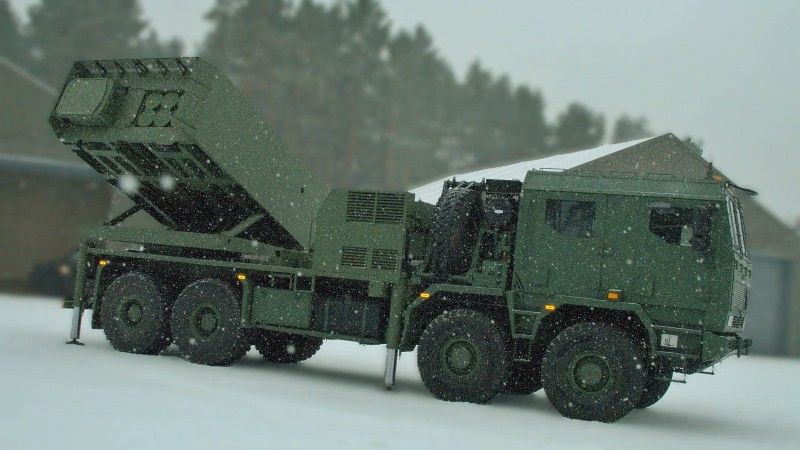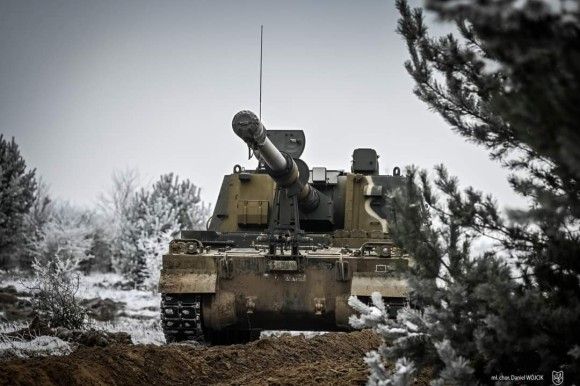Land Forces
Polish Artillery Day: A Lot to Celebrate, with Grand Challenges Ahead

Photo. cpr. Jarosław Kusz/18 Artillery Regiment
Last year has been special, for the Polish Rocket and Artillery elements. They have received new armament, allowing them to conduct strikes deep behind the enemy lines. As most of the attention is given to the guns and launchers, many things are overshadowed by the freshly made procurement efforts.
On 4th December, St. Barbara’s Day, the Polish Rocket and Artillery Component holds a celebration of its own as well. The Polish artillery units, for years, have been leading the modernization process in the Army. And that modernization process, more importantly, has been a comprehensive one. Not only did it involve the procurement of new assets (howitzers, launchers), but it also entailed the establishment of a national command, and support and logistics system.
2023 has been full of challenges for the Rocket and Artillery Component. 48 Korean K9A1 howitzers have been commissioned since December 2022, replacing the Krab systems transferred to Ukraine. A batch of howitzers is also being manufactured for Ukraine, based on a commercial agreement. Training regarding the Korean systems progresses well. The Korean howitzers are based on a similar chassis and feature an identical fire control system as the Krab does - and the units receiving the K9A1s had been using Krab systems in the past. We will get back to the matter of the Korean systems in the present article.
But the developments go beyond the realm of howitzers alone. Deliveries of Rak self-propelled mortars were also progressing in line with the previously adopted schedule. Poland also procured 2 types of MLRS systems: US-made M142 HIMARS (Homar-A), and Korean-made, polonized K239 Chunmoo systems (Homar-K). The latter have already been integrated with the ZZKO Topaz automated fire control system and the Polish Jelcz base platform. Another batch of US-made launchers (up to 500 examples) would also be based on a Jelcz platform (another type), and be integrated with the Topaz FCS.

Photo. 1st “Mazurska” Artillery Brigade
This compliance of C2 systems is a much-needed enhancement for the Polish rocket artillery units that would operate up to a couple of hundred MLRS systems. That enhancement steps beyond the realm of interoperability. First of all, the Topaz system is also used to manage reconnaissance assets (FlyEye UAV, newly commissioned Gladius system), secondly, having a single fire control system at one’s disposal it is much easier to train the artillery units, even if they are to use different assets.
When it comes to interoperability itself, back in 2023 the Topaz FCS was successfully tested side by side with the US AFADTS system, and the Canadian system, within the framework of the ASCA programme. The first batch of Topaz+ upgrades, taking the aforementioned capabilities into account, has also been ordered already. One could say that thanks to ASCA and Topaz developments, the Polish artillery is going through a silent revolution in the realm of data exchange and allied interoperability. Times are difficult, on the Eastern flank of NATO, thus this is a priceless development. In a situation when threat levels are high, saving precious time thanks to efficient C2 may be decisive in any engagement, becoming a life or death factor for the artillerymen.
What are the challenges ahead of the Polish Artillery? There are many. Given the space constraints regarding this article, we will discuss just the most critical ones. The first one pertains to the personnel. For now, we can say that the training system is going through a multifaceted reinforcement process, also at the Artillery and Armament Training Centre in Toruń. This matter will be discussed in the future, by Defence24.pl.
Another burning issue that needs to be addressed is ensuring the munitions« compliance, especially when it comes to the rockets. As mentioned, back in 2023 the Polish Armed Forces took delivery of two MLRS-class system types. Each of those systems can attack targets at a distance of around 80 kilometers with lighter munitions (GMLRS for Homar-A, CGR-80 for Homar-K), and at a longer range of ca. 300 kilometres, when heavy tactical missiles are used. That has, in essence, given an entirely new, and much-needed set of capabilities to the rocket artillery units. However, to maintain a proper level of such capabilities during a high-intensity conflict, a large munitions stockpile is a must. The current assumption is that Poland should launch manufacturing of the baseline munitions (80 km range) for both systems.
However, compliance of munitions is also an important task, as it happens in the case of the 155 mm artillery rounds that remain very much interchangeable. For the rocket systems that may be a bit more difficult, as both solutions use guided munitions.
When it comes to the necessity to homogenize munitions that are always in scarcity (as the conflict in Ukraine has been showing us consistently), no doubts can emerge here. Because both Homar-K and Homar-A would be using the very same C2 system (Topaz), and the guided missiles would use a similar INS/GPS guidance unit, technically this should be feasible. Politics and industrial partners« interests may stand in the way.
To fulfill that assumption, political involvement is a must - and this would be a tough task for the new Head of the Polish Ministry of Defence. Let us add that NATO, in a few years, would be operating four rocket artillery system families (M270/MLRS/HIMARS/Homar-A/Chunmoo/Homar-K - the biggest group, Israeli Lynx systems procured by a couple of European users, and an unspecified system made in France). Ensuring compliance and coherence in this area would also become an Alliance-wide challenge. However, this should also be achieved at the national level. European NATO member states, like the Netherlands, or Spain, do not consider the rocket artillery to be as important, as Poland does.
The first step towards the unification of munitions would come in the form of the integration of 122 mm rockets with the Homar-K system - these munitions are already used in the Polish Langusta solution. This is a major step forward. Not only would it allow the artillery units to train, but also to engage targets, including area targets, at shorter ranges (of up to 40 kilometres). In the longer run, unification shall also be considered for guided munitions. Even despite the fact that tasking for Homar-K and Homar-A is different, the former system is to be employed at the tactical level, while the latter is viewed as a strategic-operational asset.
On the day when the Rocket and Artillery Component feasts, the matter of self-propelled howitzers shall also be discussed, stirring controversy in the public sphere, as K9A1/K9PL howitzers were procured. One should however remember that in the current security context, the capabilities need to be established rapidly. Not only is this confirmed by work undertaken by German analysts - broadly analyzed by the opinionmakers - but also statement made by the Head of the National Security Bureau, Jacek Siewiera, who said that the Eastern Flank shall establish a relevant potential in three years to deter Russia from any potential aggression.
The establishment of capabilities steps far beyond the procurement of howitzers alone. Paradoxically, this may be an argument supporting Korean procurement. First, this buys the user some time to train the artillery units which is difficult, without relevant equipment at hand. Secondly, a boost of HSW’s production capabilities may be used first to handle other tasks and areas, including delivery of Borsuk IFVs, ZSSW turrets, and heavy IFVs sharing components with the Krab platform. Finally, HSW may also be manufacturing support vehicles for the artillery units as well.

Photo. mł. chor. Daniel Wójcik
The deliveries of the latter, under the recently signed framework agreement, would need to catch up with the delivery of the K9 howitzer (covered by the first agreement as well). Let us add that more types of support vehicles would be needed, compared to the current Krab squadrons. All of them would be delivered by the Polish industry, namely HSW and Jelcz. Further procurement of Krab howitzer, at a larger scale, has also been planned. Nonetheless, when a similar howitzer (also training-wise), may be procured abroad, with the remainder of the fire modules only available in Poland, the last element comes first, as it becomes a part of the Polish C2 system designed for the Krab platform. A major challenge emerges also when it comes to the counter-UAS capability, needed to protect both the K9 and the Krab systems.
This is just a brief discussion of challenges that have emerged ahead of the Polish artillery units. On Artillery Day, we need to wish the artillerymen all the best, and we should also wish them to have all the tools needed to establish a deterrence potential - this is the main mission assigned to them. Anyone willing to serve in the artillery units should also be supported in their efforts to make themselves better (technical/science subjects, English, physical condition) and enlist themselves in this branch of the military - there is no shortage of tasks and challenges here.
